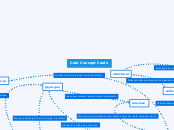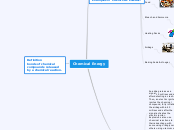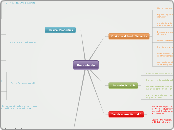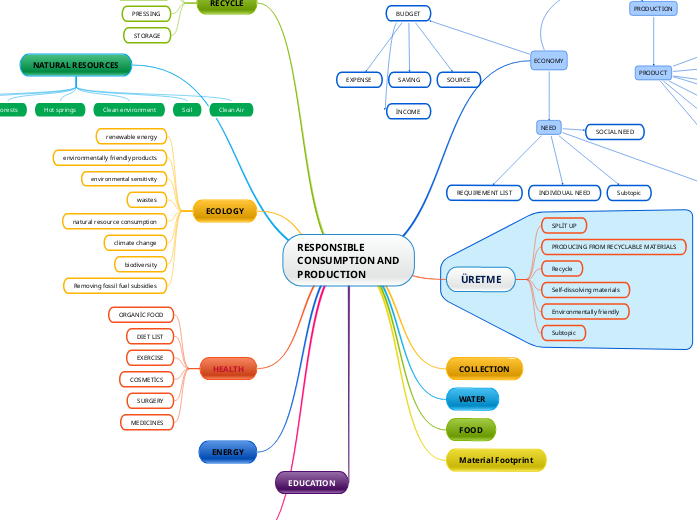Objective:
To help students understand the relationships between key concepts in solutions chemistry, such as solute, solvent, concentration, ionization, dissociation, solubility, and pH.
They should reflect on the connections and how they help in understanding the properties of solutions, especially in real-world applications like water treatment or medicine (e.g., the importance of pH in bodily fluids).
Ask students to individually modify their concept maps based on feedback from the class discussion.
Follow-Up Activity:
Discuss any differences between the concept maps and clarify misconceptions.
Encourage students to ask questions and explain how they chose to organize the concepts.
Each group presents their concept map to the class.
Class Discussion (15 minutes):
Encourage students to draw arrows between related concepts and add brief explanations for the relationships.
Third level: Terms that connect to each sub-concept, such as pH, precipitate, and aqueous solutions.
Second level: The main sub-concepts, such as solubility, concentration, dissociation, and ionization.
First level: The overarching concept of "Solutions."
Ask students to create a three-level concept map showing how these terms are related.
Give each group a large sheet of paper or digital tools for concept mapping (e.g., mind mapping software).
Divide the class into small groups of 3-4 students.
Group Work (20 minutes):
Provide a brief review of the key concepts: solute, solvent, concentration, ionization, dissociation, solubility, pH, precipitate, and aqueous solutions.
Chemical Bonding Lesson Outline
Begin by explaining to students that they will be using a concept map to explore how different terms and processes in solutions chemistry are interconnected.
Introduction (10 minutes):
Instructions:
Activity Title: Exploring the Chemistry of Solutions Using a Concept Map
Facilitates Collaboration
Supports Retention
Enhance Understanding
Encourage Active Learning
Use of Concept Maps/Graphic Organizers in Chemistry
Venn Diagrams
Spider Diagrams
Flowcharts
Hierarchical Maps
WHAT IS AN ION
There are millions of different compounds around you. Probably everything you can see is one type of compound or another. When elements join and become compounds, they lose many of their individual traits. Sodium (Na) alone is very reactive. But when sodium and chlorine (Cl) combine, they form a non-reactive substance called sodium chloride (table salt, NaCl). New compounds have few or none of the physical or chemical traits of the original elements. They have a new life of their own.
What are ions
Trends in Periodic Table
Touch, taste, smell, look and hear to identify the physical properties.out of these we do not try to taste and smell most of the chemicals: safety procedures. Physical forces alone (unless you're inside of the Sun or something extreme) rarely break down compounds completely. You can apply heat to melt an ice cube, but there will be no change in the water molecules. You can also place a cup of water in a container and decrease the pressure. The water will eventually boil, but the molecules will not change.
Improves Memory Recall
Example: Creating a map of the periodic table trends.
Benefit: Enhances long-term memory through visual cues.
Organizes Knowledge Logically
Example: Structuring the steps of the scientific method.
Benefit: Facilitates easier retrieval of information during exams.
Structuring the steps of the scientific method can help organize knowledge logically
Mapping periodic table trends can improve memory recall
Using visual cues can enhance long-term memory
Organizing information logically can aid in easier retrieval during exams
Creating visual maps can help improve memory recall
Quantum Mechanics
Created By Namita Lakra
ionization energy
The general trend is for ionization energy to decrease moving from top to bottom down a periodic table group. Moving down a group, a valence shell is added. The outermost electrons are further from the positive-charged nucleus, so they are easier to remove.
The general trend is for ionization energy to increase moving from left to right across an element period. Moving left to right across a period, atomic radius decreases, so electrons are more attracted to the (closer) nucleus.
Ionization energy exhibits periodicity on the periodic table.
The most common units of ionization energy are kilojoules per mole (kJ/M) or electron volts (eV).
Ionization energy is the minimum energy required to remove an electron from an atom or ion in the gas phase.
Key Points
The reason for the discrepancy is due to the electron configuration of these elements and Hund's rule. For beryllium, the first ionization potential electron comes from the 2s orbital, although ionization of boron involves a 2p electron. For both nitrogen and oxygen, the electron comes from the 2p orbital, but the spin is the same for all 2p nitrogen electrons, while there is a set of paired electrons in one of the 2p oxygen orbitals.
If you look at a chart of first ionization energies, two exceptions to the trend are readily apparent. The first ionization energy of boron is less than that of beryllium and the first ionization energy of oxygen is less than that of nitrogen.
H(g) → H+(g) + e-
Exceptions to the Ionization Energy Trend
ΔH° = -1312.0 kJ/mol
The first ionization energy of hydrogen may be represented by the following equation:
The energy required to remove the outermost valence electron from a neutral atom is the first ionization energy. The second ionization energy is that required to remove the next electron, and so on. The second ionization energy is always higher than the first ionization energy. Take, for example, an alkali metal atom. Removing the first electron is relatively easy because its loss gives the atom a stable electron shell. Removing the second electron involves a new electron shell that is closer and more tightly bound to the atomic nucleus.
First, Second, and Subsequent Ionization Energies
Ionization decreases moving top to bottom down an element group (column). This is because the principal quantum number of the outermost electron increases moving down a group. There are more protons in atoms moving down a group (greater positive charge), yet the effect is to pull in the electron shells, making them smaller and screening outer electrons from the attractive force of the nucleus. More electron shells are added moving down a group, so the outermost electron becomes increasingly distance from the nucleus.
Ionization energy generally increases moving from left to right across an element period (row). This is because the atomic radius generally decreases moving across a period, so there is a greater effective attraction between the negatively charged electrons and positively-charged nucleus. Ionization is at its minimum value for the alkali metal on the left side of the table and a maximum for the noble gas on the far right side of a period. The noble gas has a filled valence shell, so it resists electron removal.
Ionization, together with atomic and ionic radius, electronegativity, electron affinity, and metallicity, follows a trend on the periodic table of elements.
Ionization Energy Trend in the Periodic Table
Units: Ionization energy is reported in units of kilojoule per mole (kJ/mol) or electron volts (eV).
Also Known As: ionization potential, IE, IP, ΔH°
You may think of ionization energy as a measure of the difficulty of removing electron or the strength by which an electron is bound. The higher the ionization energy, the more difficult it is to remove an electron. Therefore, ionization energy is in indicator of reactivity. Ionization energy is important because it can be used to help predict the strength of chemical bonds.
Ionization energy is the energy required to remove an electron from a gaseous atom or ion. The first or initial ionization energy or Ei of an atom or molecule is the energy required to remove one mole of electrons from one mole of isolated gaseous atoms or ions.
When to use Concept Topic
Throughout the curriculum
For Self-Study
During Assessments
After Lessons
During Lessons
Before Lessons
How to Use Concept Maps?
Assessment Preparation
Project/Assignment Support
As a Tool of Summarization
For Comparative Analysis
Classroom Introduction
Group Learning
Example: Students collaboratively create a map on chemical equilibrium.
Benefit: Encourages sharing of diverse ideas and perspectives.
Idea Sharing
Example: Exchanging maps on different types of chemical reactions.
Benefit: Enhances collective understanding and fills knowledge gaps.
Group learning allows students to benefit from the different perspectives and ideas of their peers
Exchanging maps on chemical equilibrium can help fill knowledge gaps and improve collective understanding
Collaborative learning promotes the sharing of diverse ideas and perspectives among students
Sharing maps on different types of chemical reactions can help students broaden their knowledge
Students can work together to create a map on chemical equilibrium to deepen their understanding
Introduction to New Topics
Example: Starting a unit on thermodynamics with a concept map outlining key principles.
Method: Teacher presents a preliminary map to guide the lesson.
Review of Prior Knowledge
Example: Mapping out previous lessons on atomic structure before delving into molecular chemistry.
Method: Students fill in or expand upon existing maps.
Electronegativity
What is electronegativity
Definition
Electronegativity is a measure of the tendency of an atom to attract a bonding pair of electrons. Electronegativity differs from electron affinity because electron affinity is the actual energy released when an atom gains an electron. Electronegativity is not measured in energy units, but is rather a relative scale. All elements are compared to one another, with the most electronegative element, fluorine, being assigned an electronegativity value of 3.98. Fluorine attracts electrons better than any other element. The table below shows the electronegativity values for the elements.
Types of Matter
Solid
gases
liquid
Physical properties
5 senses
Sink or Float with the Cookie Monster
Chemical properties
explanation
Naming Compounds
Visual Representation of Complex Ideas
Example: Illustrating the structure of an atom with electrons, protons, and neutrons.
Benefit: Simplifies abstract concepts into manageable visuals.
Connects Concepts
Example: Linking chemical bonding types (ionic, covalent, metallic) with their properties.
Benefit: Shows relationships and dependencies between different topics.
Encourages Critical Thinking
Example: Analyzing how changes in temperature affect reaction rates.
Benefit: Promotes deeper analysis and synthesis of information.
Linking chemical bonding types with their properties through visuals aids in understanding the different bonding behaviors
Illustrating the structure of an atom with electrons
and neutrons helps to visualize its composition
protons
Visual representations encourage critical thinking by analyzing the impact of temperature changes on reaction rates
Connecting concepts through visuals helps to show relationships and dependencies between different topics
Using visuals to represent complex ideas simplifies abstract concepts for better understanding
Problem- Solving
Solving Chemical Equations
Example: Mapping out steps to balance complex chemical equations.
Method: Visual step-by-step guides to approach problems systematically.
Predicting Reactions
Example: Using maps to predict products of synthesis and decomposition reactions.
Method: Linking reactants to possible products based on reaction types.
Assessment Categories for Concept Maps/Graphic Organizers:
Student Participation
Example: Students actively constructing maps during lab activities.
Benefit: Increases engagement and ownership of learning.
Interactive Learning Process
Example: Using digital concept mapping tools to interact with content.
Benefit: Makes learning dynamic and adaptable to different learning styles.
Constructing maps during lab activities increases student engagement and ownership of learning
Using digital concept mapping tools makes learning more dynamic and engaging
Interactive learning processes with concept mapping accommodate diverse learning styles
Students constructing maps during lab activities promotes active participation
Using digital tools for concept mapping enhances the interactive learning experience
Content Accuracy
Relevance of Information: Ensure the key terms and concepts are accurate and relevant to the topic.
Concept Connections: Check for correct relationships between the connected terms.
Structure & Organization
Hierarchy: Evaluate if the map presents a clear hierarchy of information with main ideas at the top and supporting ideas below.
Clarity of Connections: Assess how clearly the concepts are linked and how well the connections reflect relationships between ideas (e.g., "cause-effect," "part-whole").
Completeness
Comprehensive Coverage: Determine if the concept map includes all necessary concepts, without omitting key terms or ideas.
Depth of Explanation: Review whether the relationships between concepts are explained in sufficient detail.
Visual Presentation
Legibility: Assess the overall clarity of the text, including font size, line thickness, and spacing between elements.
Use of Visual Cues: Consider the effective use of color, shapes, and arrows to indicate different types of relationships or to emphasize key points.
Creativity & Originality
Innovative Use of Concepts: Evaluate whether the student brings new insights or creative approaches in representing the connections between terms.
Engagement: Determine how engaging the concept map is, considering the layout and design choices.
Effectiveness of Communication
Clarity: Ensure the overall message is easy to follow and that the relationships between ideas are easy to understand.
Coherence: The flow of information should be logical, allowing the viewer to follow the progression of ideas without confusion.
Why Use Concept Maps?
screen
Kinematics
Equations
Acceleration and velocities
Initial and Final Velocity
Force of gravity (9.8m/s2)
Different Dimensions
2D
Must involve vectors with directions
May require using trigonometry and Sine Law
1D
Simple addition and subtraction
atomic radius
What are isotopes
Isotopes can also be a variation of an element. An example of this would be the difference between hydrogen and deuterium, which is a form of hydrogen. Pure hydrogen is devoid of a neutron while deuterium has two. Both of these elements have isotopic atoms.
An isotope is similar to an ion with one fundamental difference. While both ions and isotopes have a specific number of protons and electrons, an isotopic atom is specific to a particular element, like say, hydrogen. The number of protons and electrons are also often atypical, or not normal for a basic atom. This means ions are easily defined by the exact number of protons and neutrons in the nucleus. This tells you what kind of element it is.
Examples of Isotopes
WHAT IS AN ISOTOPE
Ionic and Covalent Boding
SubThere are two main types of chemical bonds that hold atoms together: covalent and ionic/electrovalent bonds. Atoms that share electrons in a chemical bond have covalent bonds. An oxygen molecule (O2) is a good example of a molecule with a covalent bond. Ionic bonds occur when electrons are donated from one atom to another. Table salt (NaCl) is a common example of a compound with an ionic bond.
topic
Atomic Mass
Atomic Number
Creative Chemistry Hangman Game
Lewis dot Diagram
An ion is a positively or negatively charged particle and can also be an atom or molecule that has lost or gained one or more electrons. An ion itself primarily consists of protons, neutrons and electrons. The composition of these particles can describe the type of atom that has been created. For example, an atom with an equal number of protons and neutrons is considered neutral, whereas an atom that has more protons than electrons is considered a positively charged atom. On the other hand, atoms filled with more electrons are considered negatively charged.
Bohr's-Rutherford Diagram
Properties of Water
solutions
solute
solvent
mixtures
heterogenous
homogenous
Periodic Table
compounds
A compound is a molecule made of atoms from different elements. All compounds are molecules, but not all molecules are compounds. Hydrogen gas (H2) is a molecule, but not a compound because it is made of only one element. Water (H2O) can be called a molecule or a compound because it is made of hydrogen (H) and oxygen (O) atoms.
molecules
A molecule is the smallest particle in a chemical element or compound that has the chemical properties of that element or compound. Molecules are made up of atoms that are held together by chemical bonds. These bonds form as a result of the sharing or exchange of electrons among atoms. The atoms of certain elements readily bond with other atoms to form molecules. Examples of such elements are oxygen and chlorine. The atoms of some elements do not easily bond with other atoms. Examples are neon and argon.
atoms
Atoms are the basic units of matter and the defining structure of elements. The term "atom" comes from the Greek word for indivisible, because it was once thought that atoms were the smallest things in the universe and could not be divided. We now know that atoms are made up of three particles: protons, neutrons and electrons — which are composed of even smaller particles such as quarks.
Subtopic
Credit: general-fmv Shutterstock
Structure of a beryllium atom: four protons, four neutrons and four electrons.
MORE
elements
Chemical changes in compounds happen when chemical bonds are created or destroyed. Forces act on the bonds between atoms, changing the molecular structure of a substance. You can pour liquid acid on a solid and watch the solid dissolve. That process is a chemical change because molecular bonds are being created and destroyed. Geologists pour acids on rocks to test for certain compounds.
All you can see on periodic table. In chemistry, any material (such as carbon, hydrogen, iron, or oxygen) that cannot be broken down into more fundamental substances. Each chemical element has a specific type of atom, and chemical compounds are created when atoms of different elements are bound together into molecules. There are 119 chemical elements whose discovery has been claimed; 92 occur in nature, and the rest have been produced in laboratories.
Main topic
solid
enthalpy change of reactions
when data of calorimetry experiment is absent
if molar enthalpies of formation of reactants and products are given
ΔH= ∑molar enthalpy of formation of products - ∑molar enthalpy of formation of reactants
if bond enthalpies of reactants are products are given
ΔH= sum of bond enthalpies of reactants- sum of bond enthalpies of products
if two or more other reactions and their enthalpy changes are given
use Hess's law
calorimetry
Q=mcΔT









